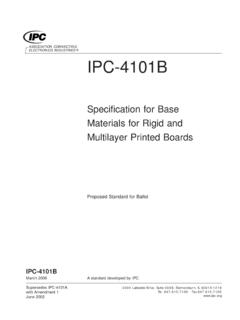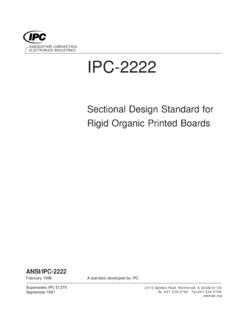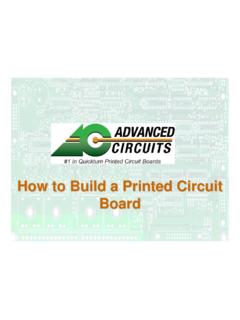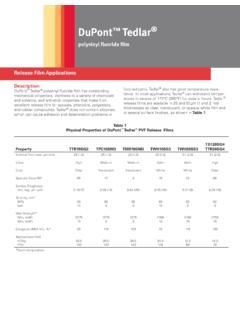Transcription of Technology information Materials 1. Introduction General ...
1 InformationMaterialsIntroduction1. Differing requirements on printed circuit boards make the use of differing substrate Materials emphasis is increasingly being put on the reliability of printed circuit boards. For many standard applications the classical FR4 material is sufficient, maybe with improved thermo-mechanical characteristics. However, at high frequencies for instance, other Materials have to be used. This Technology information sheet should provide you with a basic overview of the types of material commonly available on the market, together with their fundamental characteristics, to make it easier for you to choose the right material for your characteristics of laminates2. All of the basic Materials mentioned, which are used at CONTAG, comply with the current versions of the following international standards:MaterialStandardBase material for rigid circuit boards, 1 and 2 sided, multilayerIPC-4101 Base material for HF applicationsIPC-4103 Laminated copper films for flexible printed circuitsIPC-4204 Flexible adhesive coated films for flexible printed circuitsIPC-4203 The characteristics of the base Materials can be divided into mechanical, electrical and thermal properties.
2 Apart from electrical characteristics in part needed for special applications, the thermal characteristics mainly determine the usability and reliability of the characteristics: The key parameters are less the glass transition temperature Tg, but rather the delamination time at 260 C and 288 C, the coefficient of thermal expansion (CTE) along the X, Y & Z axes, and susceptibility to thermal cycle tests. The increased soldering temperature for lead-free solder means an increase in the thermal stress on the printed circuit board , which increases the danger of cracked sleeves, corner cracks, copper lifting and the reliability of printed circuit boards in automotive applications is increasingly checked using cyclical temperature tests. Typical conditions for this are -40 C to +125 C / >500 cycles or 40 C to +140 C / 1000 cycles.
3 This performance is only provided by Materials with limited expansion along the Z axis, in other words with a low CTE (z).While the Tg can only serve as a guideline for a permanent thermal stress of the printed circuit board (approx. 20 C - 25 C below the Tg), the other characteristics mentioned, especially the CTE(z) are the relevant values when considering the reliability of the circuit. "Modern" FR4 substrates using an FR4 resin system have these characteristics, but only have a Tg of 140 C - 150 characteristics:Dielectric constants (related to a defined frequency, mostly specified at 1 MHz, 1 GHz and 10 GHz) -Loss angle (related to a defined frequency - see above) -Proof voltage -Resistivity -Surface resistance -CTI (Conductive Tracking Index), describes the susceptibility to tracking current -CAF resistance (conductive anodic filament - electromigration between vias) -Mechanical characteristics:Adhesion of the Cu foil -Bending strength -Elasticity -Other characteristics:Water absorption -Density -Do the base Materials conform to RoHS?
4 All of the common Materials on the market comply with the RoHS/WEEE specifications, without restriction. In addition to this, there are also genuinely "green substrates" which completely do without halogens as flame retardants. These also have a very good thermal performance, but could not get established as a standard material owing to significantly higher costs and increased tool wear when drilling and for a few selected typical groups of materials3. Materials groupTgCTEz r(1 MHz/1 GHz/10 GHz)Proof volt-ageSurface resistanceConduc-tive Track-ing Index (CTI)Water absorp-tionCu adhe-sion Cppm/K-KV/mmM V%N/mmStandard FR4125 C-140 C<704,7/4,3/-50107>2000,061,5 Modified FR4135 C-180 C<554,6/4,2/-45107>2000,061,5FR4 halogen free150 C-170 C<405,0/4,8/4,650108>5000,061,5BT epoxyApprox.
5 200 C<404,4/4,1/-70108>2000,051,6CE epoxyApprox. 250 C<253,9/3,7/3,565107>2000,051,6 Polyimide220 C-260 C<554,0/3,8/3,845108>1000,31 PTFE (pure)200 C-230 C<702,6/2,4/2,245107>6000,041,3RO3000-<403,0/2,8/2,630107>6000,12,5RO4000 Approx. 280 C<453,3/3,0/2,830109>6000,041,0 Example Materials for various requirements4. Standard applicationsNameReinforce-mentResinComme ntExamplesCost factor (reference: FR4 standard) **FR2 PaperPhenolLow Technology , white goods , not lead-free solderableCobrisol FR2; Ais-malibar0,3 FR3 PaperEpoxyLow Technology , white goods , almost no longer availableCobrisol FR3; Ais-malibar0,6 CEM1 PaperEpoxyLow technologyCobrisol CEM1;Aismalibar0,7 CEM3 Glass matEpoxyLow Technology ---0,8FR4 StandardGlassEpoxyTg 130 C-140 C;conforms to RoHS/WEEEMC-100 EX*, R-1766; Panasonic1,0 FR4halogen freeGlassEpoxyThermally very stable,CAF re-sistant, Tg >= 150 CDE 156, IS 500; Iso-laR-1566W; Pana-sonic1,3 Use at high temperaturesNameReinforce-mentResinComme ntExamplesCost factor (reference: FR4 standard) **FR4 medium TgGlassEpoxyTg approx.
6 140-160 C, increased thermal stability, low Z axis ex-pansion, high reliability for lead-free soldering process, often CAF resistantR-1755C; Panasonic IS 400**; Isola1,15 FR4 high TgGlassEpoxyTg approx. 160-190 C,see aver-age TgR-1755S,R-1755T, Panasonic, IS 410**, IS 420**, Isola1,4 Rigid PIGlassPolyim-ideTg approx. 260 C, high perform-ance laminate for high reliability and high operating tempera-turesG 200, P 95, P96;Isola N7000 se-ries; Nelco5 CEGlassCyanate esterTg approx. 250 C, use is rapidly declining, replace by high Tg FR4 and PI materialsN8000 series; Nelco2,5 BTGlassBismale-imide-triazine resinTg approx. 200 C, very low ther-mal expansion, use is rapidly de-clining, replace by high Tg FR4 and PI materialsN5000 series; Nelco2,53/3 Version: B Issue date: Controlled impedance & HF applicationsNameReinforce-mentResinComme ntExamplesCost factor (reference: FR4 standard) **TeflonCeramic fillerPTFES uited for machining, assembly of multilayer and hybrid systems possible with FR4RO3003 ;Rogers4 TeflonGlassPTFEVery low r values, high CTE (z)RT5870 , RT5880 ; Rogers3 PolymersCeramic fillerDuro-plastSuitability for machining is simi-lar to FR4, assembly of multilay-er and hybrid systems possible with FR4RO4003C **, RO4350 **; Rogers, 25N**.
7 Arlon3,5 VariousGlassEpoxyLow and constant r values and loss angle, high Tg, thermal per-formance and suitability for ma-chining are similar to FR4IS620, IS640; Isola3 Flexible applicationsNameReinforce-mentResinComme ntExamplesCost factor (reference: FR4 standard) **Polyimide with acrylic adhesive------For dynamic flexible applica-tions, adhesive has a very large CTE(z)Pyralux LF/FR se-ries**; DuPont5 Polyimide with epoxy adhesive------For semi-dynamic and static flexible applicationsTeclam series*; DuPont Akaflex series*; Krempel3 Adhesive free polyimide------For dynamic flexible applica-tions, good thermal perform-anceEspanex series*; Nippon Steel AP se-ries **; DuPont5-6 LCP (Liquid Crystal Poly-mer)------For dynamic, flexible applica-tions, very good thermal per-formance, low water absorp-tion, also suited for HF applica-tions in the high GHz range R/flex 3600, R/flex 3850; Rogers 8-10 *) Standard material at CONTAG **) Various thicknesses in stock **) The factors always relate to costs in series production.
8 material orders for small quantities with short delivery times can lead to delays at There is no universal base material for printed circuit boards. Whether for standard applications, HF, high temperature or other applications: A large number of substrate types is available. For further technological questions concerning circuit boards, please contact our team of technologists (Tel. 030/351 788 155).






